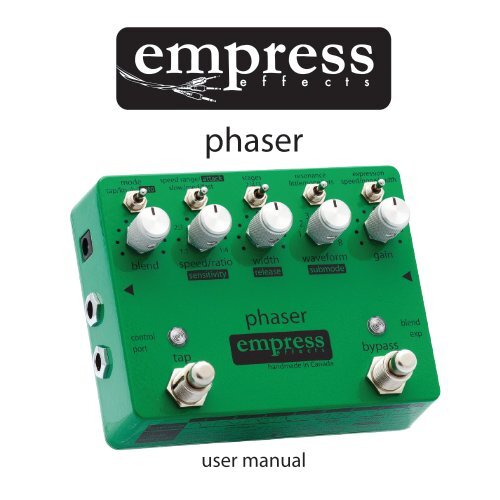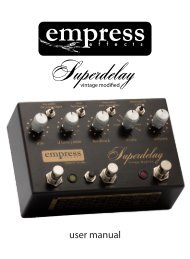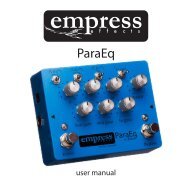Create successful ePaper yourself
Turn your PDF publications into a flip-book with our unique Google optimized e-Paper software.
<strong>phaser</strong>user manual
IntroductionThe <strong>Empress</strong> Phaser was designed to give you maximum control in asmall, manageable package. We’ve combined features that willenable you to realize all your phasing dreams.You’ll recognize the tap feature from our other pedals. And, withthe <strong>Empress</strong> Phaser, we’ve also introduced the universal controlport. Now you can control your <strong>phaser</strong> from a control voltage (CV),an expression pedal, an external audio input, external tap switch, orvia MIDI.Under the hood we’ve included a couple switches which allow youto change the pedal’s configuration. There’s a switch to enable avibrato mode and a switch that adds some pleasing harmonics tothe signal if clean and pristine isn’t your thing.To help you get the most out of this product, we’ve put up somebrief instructional videos on our website:www.empresseffects.com
Quick StartSet the knobs and switches to match the picture above. If the bluebypass LED is not already lit, press the bypass switch to engage the<strong>phaser</strong>.
Operating ModesThe <strong>phaser</strong> has three modes: knob mode, tap mode and auto mode.Knob mode: The speed of the <strong>phaser</strong> is set with the speed knob andthe speed range switch. The fastest speed range will give you ringmodulator type sounds.Tap mode: The speed is set by tapping in a tempo with the tapstomp switch. The speed of the effect will be the tapped tempo,multiplied by the ratio set using the ratio knob. For example, if youset the ratio knob at 1:2, the speed of the <strong>phaser</strong> will be twice asfast as the tempo tapped.Auto mode: In auto mode, the effect parameters are changed basedon how you are playing. We’ve set out an entire section in thismanual to explain this very cool and deep mode. You will also find ahandy reference chart printed on the front of the pedal.
Auto ModeIn auto mode, the effect parameters are changed based on how youare playing. The changes follow the envelope of the input signal, orare triggered by sudden changes in the signal volume.<strong>Effects</strong> parameters are changed in one of two ways when you useauto mode:1. Envelope FollowerWhen following an envelope in auto mode, the pedal tracksthe input volume and changes a parameter to follow thechanges in the volume level. The envelope follow approachis used in submodes 1 through 4.2. Trigger DetectionWhen detecting a trigger in auto mode, the pedal tracks thesignal and when a sudden, rapid increase in volume occurs,it changes the parameter from a low to high value. The kindof actions that would set off a trigger might be anaggressive strum on a guitar or a chord hit on a Rhodes. Thetrigger detection approach is used in submodes 5 and 6.
The Attack and Release ControlsIn submodes 1 through 4, the attack switch determines how quicklythe pedal reacts to an increase in input signal volume.For example, with submode 2 selected and the attack set to fast, asudden increase in volume will increase the <strong>phaser</strong> rate almostinstantly. With the attack set to slow, it takes much longer for thespeed of the effect to increase.The release knob controls how quickly the pedal reacts to adecrease in input signal volume. Set fully counter-clockwise therelease time is the fastest. Set fully clockwise the release time is theslowest.A slower release time generally sounds a bit smoother and a fasterrelease time, more abrupt and jarring.In submodes 5 and 6, the attack switch sets the speed at which theparameter moves from its minimum to maximum value. The releaseknob sets the speed at which the parameter returns back to itsstarting value.
SensitivityThe sensitivity knob controls how the pedal listens to your inputsignal when in auto mode. For softer input signals you should setthe sensitivity to a higher value. For louder input signals it should beturned down.In an auto mode that uses trigger detection, the red LED above thetap switch indicates that a trigger has been detected. If you find theauto mode is missing some of the triggers, increase the sensitivity. Ifyou find the auto mode is triggering when it shouldn’t be, decreasethe sensitivity.When the pedal is in a submode that uses envelope detection thered LED above the tap switch will light up when it is detectingmaximum volume. Ideally, in envelope based submodes, the LEDwill only light up when you’re playing your absolute loudest. Thiswill ensure you are experiencing the full range of parameter sweep.Setting the expression switch to ‘speed’ will allow you to control thesensitivity with an expression pedal.
The SubmodesThere are eight submodes available in auto mode.Submode 1: Phase Shift Follows EnvelopeThe center of the phase shift changes according to how loudyou play. Hitting the tap switch inverts the phasing motionfor a different tone.Submode 2: LFO On EnvelopeThe speed and the center of the phasing effect are bothincreased as the input signal grows louder. The tap switchreverses the changes as the signal grow louder.Submode 3: Speed Follows Envelope (Sine Waveform)As the instrument signal gets louder the speed of thephasing effect increases. The waveform selected for thismode is a sine wave with a width of 50%. Press the tapswitch to have the speed slow down as the instrumentvolume increases.Try the attack and release set fast so that the envelopetracking is very tight. The sensitivity controls the fastestspeed that will be reached when the signal is loudest.
Submode 4: Speed Follows Envelope (Random Waveform)Similar to submode 3 except it uses a random stepwaveform. The louder the input signal the more frequentlya new speed value is chosen at random for the effect.Hitting the tap switch reverses the action so that a loudersignal causes the waveform to slow down.Submode 5: Follow TriggerA peak in the volume of the input signal will trigger theeffect to shift from maximum phasing to minimum phasing.Hitting the tap switch inverts the phasing motion for adifferent tone. The LED above the tap switch turns redwhen a trigger is detected.Submode 6: Trigger Random LevelWhen a trigger is detected the amount of phase is shiftedto a new, random amount. This mode sounds close to arandom waveform, but the changes can be controlled andtriggered by how loud you play your instrument. In thismode, the release knob determines how quickly it shiftsfrom the current random level to the next. The attacktoggle has no effect.
Submode 7: Rhythm ModeCycle through preset rhythm patterns by turning the ratioknob. Each ratio represents a different pattern. You canchange the speed of the rhythm pattern by hitting the tapstomp switch. There are five different rhythms available foryou to explore. The release knob determines how quickly itshifts from the current random level to the next randomlevel in the rhythm. Here are the different patterns:RatioKnobTimeSignature1:1 3/4Rhythm2:3 2/41:2 5/41:3 6/81:4 4/4
Submode 8: Direct Control ModeWithout an expression pedal plugged in to the control port,this mode operates like submode 5, except that it triggersonly when you hit the tap stomp switch. Hold down the tapswitch and the sweep will keep rising to its maximumvalue. Release the tap switch and the sweep will return toits starting value.If you plug an expression pedal into the control port, thissubmode will allow you to control the degree of phaseshift with the expression pedal. The speed knob, widthknob, and expression switch are ignored in this mode.
stages: selects the number of all-pass poles. The2-pole setting sounds the least effected, 4-pole isthe setting you’ll find in most one-knob <strong>phaser</strong>s, and3-pole sounds quite different from bothControls apower: + - 9tip 2.1mm jack. 12speed range: controls the range of speeds availableon the speed/ratio knobmode: set to control the speed with either tap orknob. Select auto mode to use the audio input tocontrol the <strong>phaser</strong> dynamicallyblend: controls the mix between the original signaland the phase-shifted signal. Fully clockwise willresult in the deepest phase cancellationsspeed/ratio: with the mode switch set to tap, this knobsets the multiplication ratio for the tapped tempo.With mode set to knob, this controls the speed of the<strong>phaser</strong>tap stompswitch: use to set the speed of the <strong>phaser</strong>.Tempo will be multiplied by the current setting on theratio knob* these controls are for tap and knob modes. Auto mode uses the control
t a GlanceV - 18V DC negative0mA or greaterresonance: selects the amount of feedback applied,creating resonant peaks in between valleysexpression: selects which knob the expression pedalwill control via the control portgain: controls the output gain. The point where unitygain lies depends on the pedal’s other settingswaveform: selects between 8 different waveformsasymwidth: determines how far the phase shift variesfrom the center positionbypass stompswitch: when the LED is shining, the<strong>phaser</strong> effect is applied to the signal. When off, the <strong>phaser</strong>is being bypassed (true bypass)s marked with inverted text. These are outlined in the auto mode section
Mix/Blend and Vibrato ConfigurationThe <strong>Empress</strong> Phaser allows the blend knob to be configuredeither as a blend knob, or a mix knob.It ships configured as a blend knob. In this configuration there isa constant amount of dry signal. As you turn the blend knobclockwise, wet signal is added in.In mix knob mode, with the knob turned 100% clockwise, youhear only phased signal. When the knob is in this position thereis no dry signal being added to the wet signal so you’ll get avibrato type effect. The more you increase the width and speed,the more pronounced the effect becomes.To get a regular <strong>phaser</strong> sound when the pedal is in the mixconfiguration, set the knob to the 12 o’clock position. This addsthe dry and wet signal at equal volumes giving you maximumphase cancellation.
Changing the Mix/Blend ConfigurationTo change the mix/blend configuration, open up the pedal andlocate the DIP switches labelled ‘BLEND’.CONFIGURATION DIP1 DIP2 DIP3 DIP4Blend (default) OFF ON OFF ONMix OFF OFF ON OFFHarmonic Enhancement CircuitThe <strong>Empress</strong> Phaser has a clean and pristine sound by design. Insome instances, a dirtier sounding <strong>phaser</strong> may be desired. Toaccomplish this, we’ve included a circuit which adds subtle, yetpleasing, even order harmonics to the wet signal.Engaging the Harmonic Enhancement CircuitEngaging the circuit can be done by opening up your <strong>phaser</strong> andlocating the ‘BLEND’ dip array. Switching DIP1 on or off turns theharmonic enhancement circuit on and off accordingly.
Universal Control PortConfiguring the Control PortThe control port configuration is set using the dip-switch arrayinside the unit. When you open the <strong>phaser</strong>, you’ll see a set of 3dip-switches labelled ‘CON JACK CONFIG’. On power up, theconfiguration will be changed to the new setting. Here’s a tableof the dip settings for the various configurations:MODE DIP1 DIP2 DIP3Expression (default) OFF OFF OFFControl Voltage ON OFF OFFExternal Tap – Latching OFF ON OFFExternal Tap – Momentary(normally open)OFF OFF ONExternal Tap – Momentary(normally closed)ON ON OFFAudio Input ON OFF ONMIDI OFF ON ON
Expression Pedal ConfigurationThe pedal ships in this configuration. Plug an expression pedal intothe control port, and use the expression switch to select whichparameter you’d like to control with the pedal. You can select speedor width when using knob and tap modes. In auto mode the speedand width switch positions will control sensitivity and release,respectively. The expression pedal varies the parameter betweenzero (or fully counter-clockwise) and the setting on the knob. Inother words, the knob sets the maximum.Any expression pedal used with the <strong>Empress</strong> Phaser should have:Tip - signalRing - powerSleeve - groundControl Voltage ConfigurationIn this configuration, width and speed parameters can be controlledby an external control voltage. The <strong>Empress</strong> Phaser works withcontrol voltages which sweep between 0V and 5V.
External Tap Switch ConfigurationIn this configuration you can plug an external tap switch into thecontrol port to set the tap time. This is useful if you have more thanone tap-tempo pedal, so that you can set them all with one switch.The <strong>Empress</strong> Phaser is able to accept both latching and momentaryexternal tap switches.External Audio ConfigurationIn this configuration you can plug an audio signal into the controlport to override the normal input. The auto modes will use theexternal audio signal to detect triggers or generate the enveloperather than the signal at the input. Try connecting a drum machineto this input.In some cases, plugging in an external audio source may create aground loop. If you hear hum introduced in the output signal whenan external audio signal is plugged in you should lift the ground ofthe incoming signal.
MIDI ControlThe <strong>Empress</strong> Phaser allows all of its digital parameters to becontrolled via MIDI control change messages, and to have its tempochanged with MIDI clock messages. To use MIDI with your <strong>phaser</strong>you’ll have to:1. Attach the <strong>Empress</strong> Midibox using a ¼” patch cable to thecontrol port. This is a simple device which converts thesignal on a standard MIDI cable to a ¼” cable you can pluginto your <strong>phaser</strong>s control port. (Not included with the<strong>phaser</strong>)2. Configure the pedal for MIDI control by setting the internalcontrol port dip switches to the MIDI mode.3. Configure the unit’s MIDI channel by setting the internal dipswitches labelled ‘MIDI CH’. Select a channel that won’tconflict with the other devices in your MIDI rig.
Control Change MessagesThe <strong>Empress</strong> Phaser can be controlled with MIDI control changemessages. Almost all MIDI controllers or digital audio workstationsoftware will be able to output these messages. Refer to yourproduct’s documentation for help on how to do this. Below is atable that shows which MIDI control change message controls each<strong>phaser</strong> parameter.Phaser Parameter CC #: Note:Speed/Ratio/Sensitivity 20 Sending a value of 0 would beequivalent to the knob completelycounter clock-wise, sending 127 isequivalent to fully clock-wise.Width/Release 21Waveform/AutoMode 22 Sending a value of 1 will set it towaveform/auto-mode 1; sending 2waveform/auto-mode 2, etc.Mode 23 Sending 1 will set it to tap mode, 2knob mode, and 3 auto mode.Speed Range/Attack 24 Sending 1 will set it to slow, 2medium, 3 fast.Tap Switch 35 Sending a value of 127 simulates theBypass Switch 36 switch being pressed. Sending avalue of 0 simulates releasing theswitch.
Direct Control 40 Sending this message overrides allother digital settings (speed, width,waveform, mode) and lets you setthe amount of phase shift directlywith MIDI values. Sending a value ofzero would correspond to minimumphase shift and 127 the maximum.This mode would allow you to drawyour own waveforms in a digitalaudio workstation and send them tothe <strong>phaser</strong>.Exit Direct Control 50 Sending this message with any valuewill cause the pedal to exit directcontrol.MIDI Clock Listener 51 Sending a value of 0 causes the pedalto ignore MIDI Clock messages.Sending a value of 127 causes thepedal to listen for MIDI Clockmessages.By default, the pedal listens for MIDIClock messages.
MIDI Channel Dip ConfigurationChannel DIP1 DIP2 DIP31 OFF OFF OFF2 ON OFF OFF3 OFF ON OFF4 ON ON OFF5 OFF OFF ON6 ON OFF ON7 OFF ON ON8 ON ON ON
MIDI Clock (aka MIDI Beat Clock)The <strong>Empress</strong> Phaser will respond to MIDI Clock messages when it isin tap and normal mode. MIDI Clock specifies quarter notes,subdivided into 24 MIDI Messages. Each quarter note correspondsto 1 period of the <strong>phaser</strong>’s waveform.Warning: Changing the speed/ratio knob when MIDI clock is beingsent will confuse the <strong>phaser</strong>. It will momentarily switch to the knobsetting, and then switch back to the MIDI clock setting causinggeneral chaos.
SpecificationsInput Impedance:1MΩOutput Impedance:2KΩFrequency Response (-3dB): 35Hz – 17kHzDistortion (All dry signal): 0.03%Noise:-104.1dBInput Voltage:9VDC – 18VDCRequired Current:120mAPower Input Connector:2.1mm Barrel ConnectorHeight (enclosure only):1.5”Height (including controls): 2”Length:3.5”Width:4.5”Weight:1lbswww.empresseffects.com





